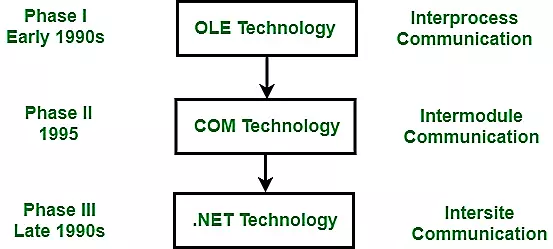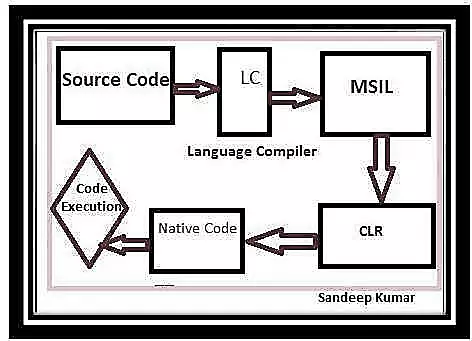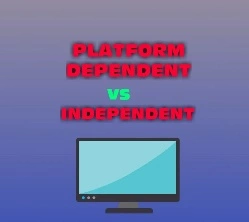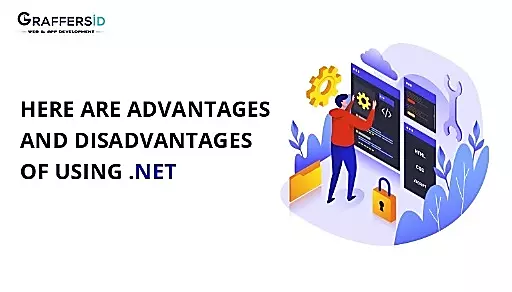The .NET Framework is a software development platform introduced by Microsoft under NGWS in the late 1990s. On 13 February 2002, Microsoft launched the first version of the .NET Framework, called .NET Framework 1.0.
In this section, we will understand the .NET Framework, features, components and its versions.
Contents
1. What is .NET
In this .NET is a software framework designed and developed by Microsoft. If we talk about this version then the first version of .NET Framework was 1.0 which came in the year 2002. In simple words, it is a virtual machine to compile and execute programs written in different languages like C#, VB.Net, etc.

So we can say that it is used to develop form-based applications, web-based applications and web services. There are a variety of programming languages available on the ASP.NET platform, VB.NET and C# being the most common. It offers a lot of functionality and supports industry standards as well.
2. There are three important stages in the development of .NET technology.
1. OLE Technology
OLE (Object Linking and Embedding) is one of Microsoft’s component document technologies. Basically, its main purpose is to link elements of different applications within each other.
2. COM Technology
A technology from the Microsoft Windows family of operating systems, Microsoft COM (Common Object Model) enables various software components to communicate. COM is mostly used by developers for various purposes such as creating reusable software components, linking components together to build applications, and leveraging Windows services. COM objects can be created with a wide range of programming languages.

3. .NET technology
The collection of .NET technology or set of technologies for developing Windows and Web applications. Net’s technology is developed by Microsoft and was launched in February 2002 according to the original definition of Microsoft’s New Internet Strategy. It is considered one of the powerful, popular and very useful internet technology available today.
3. What are the essential components of .NET
1. Common Language Runtime (CLR)
The CLR is the basic and virtual machine component of the .NET Framework. It is the run-time environment in the .NET Framework that runs the code and helps to ease the development process by providing various services such as remoting, thread management, type-safety, memory management, robustness, etc. It also helps in the management of code, because code that targets the runtime is known as managed code, and code that does not target the runtime is known as unmanaged code.

2. Framework Class Library (FCL)
It is a collection of reusable, object-oriented class libraries and methods, etc., that can be integrated with the CLR. Also called assembly. It is like header files in C/C++ and packages in Java. Installing .NET framework is basically the installation of CLR and FCL in the system. Below is an overview of the .NET Framework.
4. Is .NET Application Platform Dependent Platform and Independent.

The combination of Operating System Architecture and CPU Architecture is known as Platform. Platform dependent means the programming language code will run only on the particular operating system. A .NET application is platform dependent due to the .NET framework being able to run only on Windows-based operating systems. A .Net application is also platform-independent due to the Mono framework.
Using the Mono framework, .Net applications can run on any operating system, including Windows. Mono Framework is a third party software developed by Novell Company which is now part of Micro Focus Company. This is a paid framework.
5. History of .NET
Microsoft began developing the .NET Framework in the late 1990s, originally known as Next Generation Windows Services (NGWS), as part of the .NET strategy. By the early 2000s, the first beta version of .NET 1.0 had been released.

In August 2000, Microsoft and Intel worked to standardize the Common Language Infrastructure (CLI) and C#. By December 2001, both had been ratified to Ecma International (ECMA) standards. The International Organization for Standardization (ISO) adopted in April 2003. The current versions of the ISO standards are ISO/IEC 23271:2012 and ISO/IEC 23270:2006.
While Microsoft and their partners hold patents for the CLI and C#, ECMA and ISO require that all patents required for implementation be made available under “fair and non-discriminatory terms”. The firm agreed to fulfill these conditions and to make the patent available royalty free.
Also check:
-
5 Best Computer Course in India for Private Job (India में प्राइवेट नौकरी के लिए 05 BEST कंप्यूटर कोर्स)
-
Google jobs in India | Google में चाहिए नौकरी तो कर ये 5 कोर्स - मिलेगा लाखों का पैकेज | Google Jobs
-
Retail Management Career | Retail Jobs | How to get Retail Management Job
-
How to Start Earning as a Graphic Designer?
-
Paramedical Courses | Paramedical Career | कम बजटऔर कम फीस में मेडिकल करियर बनेगा
6. What are the advantages or disadvantages of .NET
Advantages of .NET
1. Object Oriented
.NET is based on object-oriented programming modules. OOP is a development model that involves breaking down software into easily manageable small pieces. OOP divides data into data fields and describes the behavior of objects through the declaration of classes.

2. Visual Studio IDE
- The Integrated Development Environment simplifies application development by providing the tools needed to write and test software.
- Visual Studio is an integrated development environment by Microsoft used for building, debugging and publishing applications on various platforms including Android and iOS.
- Key Features of Visual Studio IDE:
- This is a single IDE for all dotnet applications
- IDE includes debugging and integrated compilation features
- The solution can be used for applications that are based on code written in different languages.
- It also customizes the environment to match the preferences of the user.
3. Cross-platform design
.NET Core is cross-platform, which means it allows code to run on Windows, Linux, and OS X. Unlike the native .NET framework, Dotnet Core consists entirely of open source code which ensures that a wider engineering community can contribute to it. Development.
4. Flexible deployment and easy maintenance
One of the important and most advantageous features of .NET Core is flexible deployment. It can be installed as a part of the application that you are developing and as well as separately. The modular design allows you to include all the dependencies that you need. Also, deployment with .NET is as easy as copying a folder.
5. In this dotnet Core supports wide range of applications
With the .NET framework, you get an opportunity to develop applications in multiple domains like gaming, mobile, IoT, AI.
Disadvantages of .NET
1. Limited Object-Relational Support
As mentioned above, .NET works on an object-oriented programming approach, which is based on actions instead of logic and objects instead of data. Support for data-oriented software application development in the .NET Framework is provided by Entity Framework.
2. Vendor Lock-in
.NET is a framework by Microsoft. While Xamarin and .NET Core are open source, the entire ecosystem is far from being community-driven. This means that your products will be dependent on decisions made by Microsoft.
3. Memory leaks
Memory leak problem is common with every technology. .NET is also one of the platforms that is often criticized for memory-related and memory leak issues.
4. Difficulty in Transitioning to .NET Core
Transitioning to Dotnet Core can be long and difficult. Applications built with older .NET versions cost far more than applications built with .NET Core. Migrating these applications to the latest versions of .NET can be a bit difficult.
7. Conclusion
Windows applications. Judging by the evidence so far, it has certainly been a success for Microsoft and its customers. While the move to a .NET environment forces developers to climb a steep learning curve, the benefits seem to be well worth the effort. For those who use it, this technology qualifies as another step toward the end goal: to produce the best possible software in the shortest amount of time.
8. FAQ
NET is a free, cross-platform, open source developer platform for building several different types of applications. Together, NET, you can use many languages, editors, and libraries to build web, mobile, desktop, games, IoT, and more.
C# (pronounced “C-sharp”) is the de facto coding language we use in. Net framework. C# is an object-oriented programming language, which means that it can increase productivity in development processes.
The main reason, for. NET you need windows platform, which is costlier than open-source. For example, to develop. NET based web application I need which is very expensive.
.NET natively uses compiled languages such as C# and C++. They are faster and use less memory as compared to Java, NET code optimization and writing less code, which improves performance. Smaller code also means less time spent on code maintenance and simpler debugging.
- Net software developer is a software developer who specializes in creating software for Microsoft’s Windows platform. They work with programming languages that are compatible with Microsoft. NET Framework, which includes VB.NET, C# (C Sharp) and F# (F Sharp).
Developers, in general, are hard to find in the US. With the lack of talent, it is difficult to find programmers who specialize in a specific programming language. If you want your company to be successful, you need the right group of people with the right skills.
NET Core will replace it. Net framework. Eventually, NET 5.0 was rolled out in Nov 2020.


